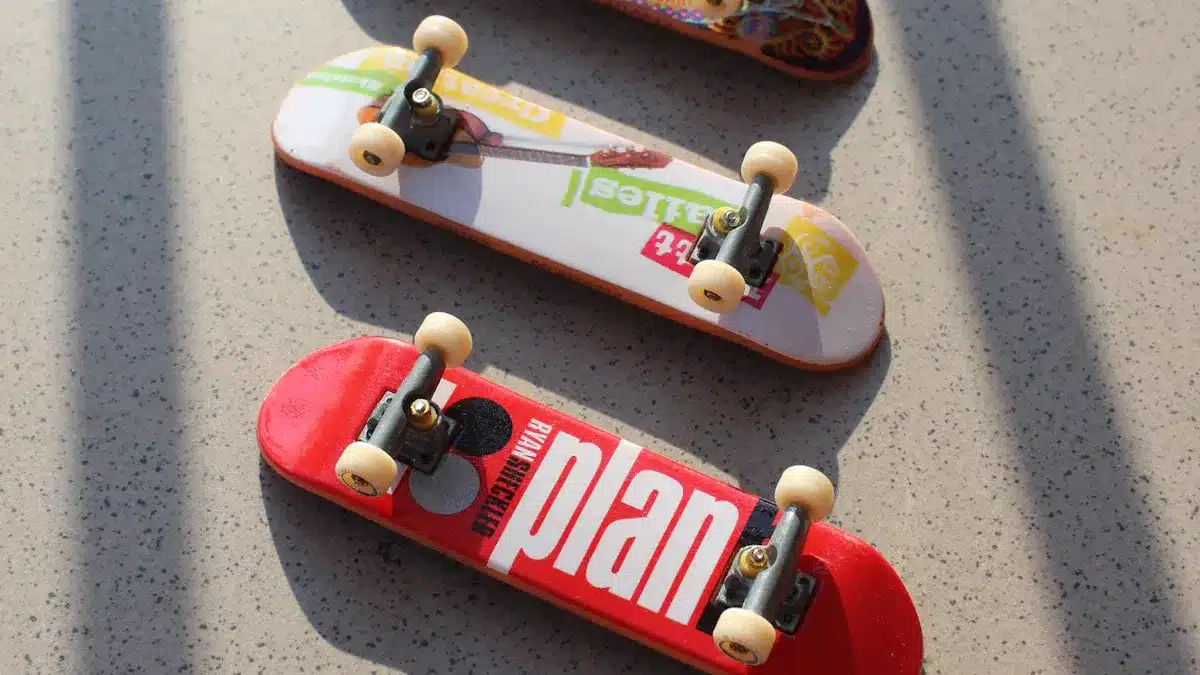
Flex boards are important parts in today’s electronics. They provide flexibility and efficiency. You can find these boards in many devices, like smartphones and medical tools. Their special designs let them bend, which is great for small and changing spaces. The worldwide market for flexible printed circuit boards is expected to grow a lot. It could reach USD 76.49 billion by 2033. This shows how important flex boards are in many fields. These include consumer electronics, cars, and airplanes.
Key Takeaways
Flex boards, also called flexible printed circuit boards, are very important in today’s electronics. They help make devices smaller and work better.
Picking the right flex board depends on what your project needs. Think about things like signal quality, how strong it is, and the price.
There are different types of flex boards, such as Block Out, Normal, and Glow Flex Boards. Each type is made for special uses.
Using flex boards can make devices lighter and save space. This makes them great for smartphones, wearables, and medical tools.
Flex boards help performance by cutting down on connections. This lowers the chance of problems and makes them more reliable.
What are Flex Boards?
Definition and Overview
Flex boards, or flexible printed circuit boards (FPCBs), are electronic circuits on flexible plastic bases. These bases often use materials like polyimide or clear conductive polyester film. The special design of flex boards lets them change shape and bend when used. This flexibility makes them different from regular rigid printed circuit boards.
A flex PCB has a pattern of printed circuits and parts made from flexible materials. This design helps the board change shape during use, which is important for many modern electronic devices. Flex boards can use flexible base materials, so they can be shaped and bent as needed. This feature is very important for places where space is tight.
Importance in Electronics
Flex boards are very important for making modern electronic devices. They allow for flexible displays, which are key for foldable smartphones and tablets. This ability lets the circuits bend and fold with the device, improving user experience. Also, flex boards are important in wearable health devices. They fit the body’s shape for constant monitoring without causing discomfort.
In smart-home and IoT uses, flexible PCBs help create sleek designs that fit into different surfaces. This improves both how they work and how they look. The use of flex boards has greatly changed technology in consumer electronics. They help make devices smaller and more powerful. This ability is very important in the consumer electronics market, where being compact and efficient matters.
Flex boards also have many benefits over traditional rigid PCBs. They reduce connection points, make assembly easier, and resist vibrations better. This flexibility allows for many designs and setups. Plus, new materials have made flex boards stronger, making them reliable for many uses, even in tough conditions.
Key Benefits of Flex Boards:
Adaptability to various shapes and sizes.
Enhanced durability and reliability.
Ability to reduce assembly costs.
Improved performance in space-limited environments.
Types of Flex Boards

Block Out Flex Boards
Block Out Flex Boards are strong and flexible. They can resist UV rays and water. This makes them good for indoor and outdoor use. Here are some key features:
Characteristic | Description |
|---|---|
Durability | Strong, UV and water resistant, good for indoor and outdoor use. |
Surface Color | Comes in snow white, milky white, bluish white, and more. |
Surface Finish | Can be glossy, semi-glossy, or matte. |
Resistance | Anti-UV, anti-mildew, cold resistant (-30-70), with optional fire ratings (FR B1, B2, M1, M2, NFPA701). |
Maximum Seamless Width | Up to 5.10 meters. |
Strength | High strength against tearing and peeling, plus good ink absorption for bright prints. |
You can use Block Out Flex Boards in many places, like:
Billboards
Indoor and outdoor displays
Banners
Building murals
Exhibition booth decoration
Advertisements and promotions
These boards are great for outdoor ads, event banners, and store displays. Their strength in tough conditions makes them a favorite for many businesses.
Normal Flex Boards
Normal Flex Boards are special because of their unique features. They usually use polyimide or polyester film, which is very stretchy. Here’s a closer look at what they offer:
Feature | Description |
|---|---|
Material | Usually made of polyimide or polyester film, which is stretchy and soft. |
Flexibility | Can move and stretch in three dimensions. |
Wiring Density | High wiring density, making it good for compact designs. |
Weight | Light weight, helping with overall design efficiency. |
Thickness | Thin, allowing it to fit in tight spaces. |
Bendability | Good bendability, making it useful for many applications. |
Normal Flex Boards are great for uses needing full board flexibility, resistance to vibrations, and 3-D shapes. Their flexibility makes them a popular choice in many electronic devices.
Star Flex Boards
Star Flex Boards provide better print quality and strength. They are especially useful for electronic displays. Here are some benefits of Star Flex Boards:
Benefit | Description |
|---|---|
Improved Print Quality | Star Flex has better print quality and color than standard flex. Its smooth surface helps create sharper images. |
Durability | Star Flex is very strong and UV resistant, perfect for long-lasting outdoor displays. |
Cost-Effectiveness | Because it lasts longer, Star Flex can save money over time. |
Flexibility | This material stays flexible in cold weather, lowering the chance of cracking or tearing. |
You can use Star Flex Boards in many areas, like signs, ads, and promotional displays. Their ability to keep quality over time makes them a smart choice.
Glow Flex Boards
Glow Flex Boards improve visibility for signs. They are made to stand out both day and night. Here are some important features:
Feature | Description |
|---|---|
Vibrant Illumination | Offers great visibility both day and night. |
Durable Materials | Made from high-quality materials for long-lasting use. |
Customizable Designs | Attracts attention with custom designs for different uses. |
Glow Flex Boards are ideal for storefronts, events, and exhibitions. Their bright light greatly improves visibility, making them a great choice for branding and advertising.
Types of Flexible Printed Circuit Boards
Single-Sided Flexible PCBs
Single-Sided Flexible PCBs have one layer of conductive material. They are simple and cheap to make. You can often find them in basic electronics like calculators and printers. Their easy design makes them quick to produce.
Double-Sided Flexible PCBs
Double-Sided Flexible PCBs have conductive layers on both sides. This design allows for more complicated circuits. You can use them in devices that need more wiring. Examples include smartphones and other small electronics.
Multi-Layer Flexible PCBs
Multi-Layer Flexible PCBs have three or more layers. They support advanced uses. These include smartphones, laptops, and medical devices. The complex design of multi-layered flexible circuits allows for detailed patterns.
Here’s a quick comparison of the three types:
Type | Layers | Complexity | Applications |
|---|---|---|---|
Single-Sided PCB | 1 | Low | Simple electronics like calculators and printers |
Double-Sided PCB | 2 | Medium | More complex devices requiring higher density |
Multi-Layer PCB | 3+ | High | Advanced applications like smartphones and laptops |
Rigid-Flex Boards
Rigid-Flex Boards mix rigid and flexible materials. They have special benefits over regular flexible PCBs. Here are some advantages:
Space Efficiency: They remove the need for connectors, fitting into small areas.
Reliability: Fewer connectors mean fewer chances of failure.
Durability: They handle mechanical stress and tough conditions.
Reduced Assembly Costs: Fewer parts lower overall assembly costs.
Complex Geometries: They allow for complex shapes and 3D designs.
You can see how Rigid-Flex Boards are great for things like cameras and drones. Their light design and strong stability make them a smart choice for tough environments.
Summary
Knowing the types of flexible printed circuit boards helps you pick the right one for your project. Each type has special features and uses. Whether you need a simple design or a complex setup, there’s a flexible PCB that works for you.
Features of Flex Boards
Material Composition
The materials in flex boards are very important for how they work. The most common materials are polyimide and polyester. Polyimide (PI) film is flexible, heat-resistant, and strong. It does not get soft when heated, which makes it great for flexible printed circuit boards. Polyester (PET) is also used, but it does not handle high temperatures well. Here’s a quick comparison of these materials:
Material | Properties |
|---|---|
Polyimide | Flexible, heat-resistant, does not soften when heated, better for flex PCBs |
Polyester | Less heat-resistant, not good for high temperatures during soldering |
Thickness and Flexibility
The thickness of a flex PCB affects how flexible and durable it is. Thinner boards can bend more easily, making them great for foldable devices or robots. But if the board is too thin, it might break or not work well because of weak traces. A thinner layer helps with flexibility and allows tighter bends, which is important for moving parts. On the other hand, a thicker layer can improve signal quality and reduce interference, which is important for fast circuits.
Thermal and Electrical Properties
Good flex boards have great thermal and electrical features. They usually have high conductivity, low resistance, and strong dielectric strength. Copper is often used because it conducts electricity well, ensuring smooth current flow. Polyimide is chosen for its strong dielectric strength, which helps the board handle high voltages without damage. Here’s a summary of the typical properties:
Property | Polyimide | Polyester |
|---|---|---|
6000 | 3400 | |
Volume Resistivity (ohm-cm) | 1.0E+16 | 3400 |
Service Temperature (min/max) (°C) | -125/+200 | -60/+105 |
These features make flex boards good for tough environments. Their small and light design helps make devices smaller, while their flexibility allows them to bend millions of times. This reliability is very important for uses in robots, cars, and airplanes.
Benefits of Using Flex Boards

Space Efficiency
Flex boards are great for saving space. Their special design lets you fit them into small areas where regular rigid printed circuit boards (PCBs) can’t go. You can shape flex PCBs to wrap around parts, so you don’t need big connectors and wires. This flexibility helps make small devices like smartphones and wearables. Here are some key benefits:
Flex PCBs can be made to fit in tight spaces.
They can bend and fold, allowing installation where regular PCBs won’t work.
You can place flex PCBs in narrow spots, helping to make devices smaller.
Weight Reduction
Another big benefit of flex boards is weight reduction. Their light design can cut package weight by up to 75%. Rigid-flex PCBs can also lower weight by 20-30% compared to regular rigid PCB setups. This weight cut is very important in places where keeping weight down matters, like in portable medical devices and consumer electronics.
Enhanced Performance
Flex boards improve performance in many uses. They increase reliability by reducing connections and solder joints, which lowers failure points. Also, flex circuits help reduce signal loss and impedance mismatch, making sure they work well. Here’s a quick look at performance boosts:
Performance Improvement | Description |
|---|---|
Space Efficiency | Flex PCBs can bend or fold to fit in tight spots, using space wisely. |
Weight Reduction | Their light weight is helpful in cases where keeping weight low is key. |
Enhanced Reliability | Fewer connections and solder joints make them more reliable, lowering failure chances. |
Improved Signal Integrity | Flex PCBs help reduce signal loss and impedance issues, ensuring strong performance. |
In real life, flex boards are used in medical devices, like wearable health monitors and implantable devices. Their ability to adapt meets strict healthcare needs, improving how they work and patient results.
Choosing the Right Flex Board
Assessing Your Project Needs
When picking a flex board, start by looking at your project needs. Think about these important factors:
Signal Integrity: High-frequency projects need low signal loss and little interference.
Mechanical Durability: Make sure the board can resist cracking or peeling when bent.
Solderability: Good soldering is important for small components.
Environmental Resistance: The board should protect against rust, moisture, and temperature changes.
Cost and Manufacturability: Your budget and how easy it is to make will affect your choice of surface finish.
Budget Considerations
Your budget is a big part of choosing the right flex board type. Here are some things to think about:
Look into options like rigid-flex designs. These can improve function while lowering the number of parts and assembly costs.
Using one rigid-flex board can replace several circuit boards, saving money directly and indirectly.
Removing wire harnesses makes assembly easier, cutting down on labor costs and time.
Manufacturer Recommendations
Picking the right manufacturer is key to getting a good flex board. Here are some important things to consider:
Design Element | Consideration | Impact |
|---|---|---|
Layer Stack-Up | Material choice, number of layers, and layout | Affects impedance, flexibility, cost, and signal quality. |
Trace Routing | Path for routing in flex and rigid areas | Influences signal performance, stress reduction, and how easy it is to make. |
Bend Radius | Minimum bend radius in flexible areas | Affects how reliable it is and its lifespan. |
Transition Zones | Smooth change between flex and rigid areas | Ensures both mechanical and electrical reliability. |
Via Placement | Placement near bending areas | Affects mechanical and electrical reliability. |
Choosing a manufacturer with good processes and skills is very important. Their knowledge will decide how complex the designs can be and the quality of the final product. Using high-quality materials, like polyimide for flexibility and copper for conductivity, is crucial for strength and performance.
Comparison of Flex Board Types
Performance Metrics
When you compare flex boards, think about several performance metrics. These metrics show how each type works in different uses. Here’s a summary of key performance metrics:
Performance Metric | Description |
|---|---|
Enhanced Signal Integrity | Reduces connections, cutting down noise and electromagnetic interference (EMI). |
High Reliability | Lowers the chance of failure with fewer solder joints; can bend and flex without breaking. |
Compact and Space-efficient Design | Fewer connectors and cables make lightweight and small devices for many uses. |
Improved Mechanical Stability | Better at handling higher mechanical stress, improving overall stability. |
Cost Analysis
Cost is another key factor when picking flex boards. Here’s a look at the costs for different types:
Frontlit Flex: Good for outdoor banners, high-quality and waterproof.
Backlite Flex: Great for glow sign boards, lets light shine through.
Blackout Flex: Blocks light completely, good for office branding and events.
Normal Flex: Most common and budget-friendly option.
These choices differ in price, so pick based on your budget and project needs.
Application Suitability
Different types of flex boards work best in various applications. For example, flexible printed circuit boards are great for wearable technology. They fit the body’s shape, ensuring comfort and function. Here are some uses where specific types excel:
Flexible PCBs: Perfect for fitness trackers and medical wearables, as they mold to the body.
Rigid-Flex PCBs: Mix rigid and flexible parts, giving stability for components while fitting into tight spaces. They are useful in smartwatches, where the rigid part holds the processor and sensors.
Picking the right flex board is very important for your project’s success. Each type has special benefits that match current industry trends, like flexibility and being eco-friendly. Think about these key points when you choose:
Consideration | Description |
|---|---|
Material Compatibility | Make sure materials work well in the environment to avoid problems. |
Thermal Stability | Materials should stay strong across different temperatures, especially in tough conditions. |
Electrical Properties | The dielectric constant and loss tangent affect how signals behave; low-loss materials are best. |
You should also talk to experts for complicated projects. Their advice can help you choose the right option. Using a step-by-step method makes sure you think about all important information and possible risks. This way, you can make smart choices that improve your project’s performance and reliability.
Key Benefits of Flex Boards:
New technologies encourage innovation.
Eco-friendly methods meet sustainability needs.
By knowing your specific needs and using expert advice, you can pick the best flex board for your project.
FAQ
What are flex boards used for?
Flex boards are found in many electronic devices. You can see them in smartphones, wearables, medical tools, and cars. Their ability to bend helps them fit into small spaces and change shapes.
How do I choose the right flex board?
To pick the right flex board, think about your project needs. Look at things like signal quality, strength, and how well it resists the environment. Your budget and how easy it is to make also matter a lot in your choice.
Are flex boards more expensive than rigid PCBs?
Flex boards can cost more than rigid PCBs because they are harder to make. But they often save money in assembly and space, making them a smart choice over time.
Can flex boards handle high temperatures?
Yes, flex boards made from polyimide can handle high heat. They stay stable and work well in tough conditions. But polyester boards do not resist heat as well and might not work in high-temperature places.
How do I maintain flex boards?
To take care of flex boards, avoid bending them too much and keep them dry. Store them in a place that is not damp. Check them often for any signs of damage to keep them working well in your devices.
See Also
Choosing the Ideal PCBA Manufacturer for Your Business Goals
Finding the Perfect Fusion PCBA Service for Your Requirements
Essential Advice for Selecting the Best Main PCBA